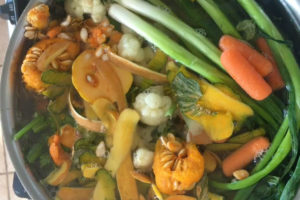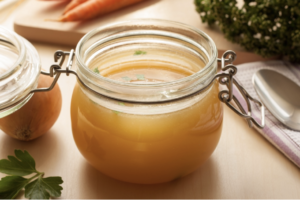GUEST POST: Using Vegetable Scraps to Enhance Nutrition and Flavor
Using Vegetable Scraps to Enhance Nutrition and Flavor
by Laura Scherling, RD
At some point in our lives we’ve all been told not to boil vegetables because “you’ll lose all the nutrients in the water!” And you know what? It’s true! This is because the water soluble vitamins found in those veggies are lost as a result of the boiling process. Vitamins come in two forms: water soluble and fat soluble. When vegetables are boiled in water, their water soluble vitamins move from the vegetables into the cooking liquid, meaning that when you eat the vegetables after boiling them, you aren’t getting those vitamins. It’s also why there are any number of better ways of cooking vegetables that retain their nutrition content—roasting, steaming, and sautéing to name just a few.
Why are the water soluble vitamins in vegetables important? Water soluble vitamins include not only valuable vitamin C, but also all of the B vitamins (thiamin, riboflavin, niacin, pyridoxine, B12, folate, pantothenic acid, biotin). Almost everyone is familiar with the powerhouse benefits of vitamin C—it helps our bodies fight colds, is a powerful antioxidant, and has been linked to preventing a variety of chronic diseases such as heart disease and possibly even cancer. The benefits of the B vitamins, however, tend to be less well known. Most people benefit from increasing their B vitamin intake because B vitamins tend to be lacking in American diets. B vitamins support our bodies during stress response and aid in metabolism of carbohydrates, fats and proteins. Women can especially benefit from increasing their B vitamins and often report an increase in energy as their intake increases. And due to their water solubility, any excess is easily eliminated through urination, making it almost impossible to take too much through diet changes alone.


So while boiling vegetables may not be ideal, especially if you throw the cooking liquid out afterward, you can use your knowledge of how water soluble vitamins work as a simple life hack to enhance the flavor and nutritional value of your food by making simple vegetable stock at home using your leftover vegetable scraps.
One of the ways professional chefs create exceptionally delicious food is by using stocks or broths in place of water in their recipes. Creamy risotto? Chicken or vegetable stock. Warm and savory seafood chowder? Seafood or vegetable stock. And so on. And while there are plenty of boxed and canned stocks and broths on the grocery store shelves, I suggest you save your money and reduce waste by making your own vegetable stock at home. And honestly, homemade stock just tastes better and has higher nutritional quality.
Want to know how to start making your own delicious vegetable stock at home? Just follow these simple steps:
First, start saving your vegetable scraps in your freezer. A large ziplock bag works really well for this (and you will use it over and over again as you repeat the process so as not to create plastic waste). Whenever you have vegetable peels or scraps, add them to the bag. Which vegetables should you use? Carrots (peels, leftover chunks, or tops), yellow or white onions (including their peels), celery tops, potato peels and scraps (all varieties), kale stems, parsley stems, leek tops, fennel greens, and corn cobs are some of my favorites and make a particularly delicious broth. According to Alison Mountford, founder of Ends and Stems, you may want to avoid asparagus, broccoli, bell peppers and cabbage due to their bitter and overpowering nature.
When your bag of vegetable scraps is full, dump the contents into a large soup pot over medium heat, cover with water, let it simmer for about two hours and then, voila! You’ve just made a wonderfully nutritious vegetable stock! Cool the stock and remove any solids from the liquid with a fine mesh strainer. You can keep your stock in the refrigerator for about a week or freeze it in containers to have on hand anytime your dish needs an injection of flavor. Use the stock in any savory recipe that calls for water or use it as an easy base for almost any soup, stew or chowder.

Once you’ve mastered the basic vegetable stock, you can begin experimenting with stocks that focus on certain textures or flavors for use in more specific dishes. With fall approaching, Mountford recommends you consider winter squash for example (including peels, seeds and guts), which will yield an orange, richly squash-like stock that will work particularly well in recipes where you want to accentuate the squash flavor, such as in a squash risotto. Similarly, tomatoes, when added to your basic stock, will give the stock a vibrant, fragrant tomato quality that will play well in dishes that call for a slightly more substantial base than your plain ol’ vegetable broth, while the addition of mushrooms will give your broth that warm earthy quality that is obviously delicious in any dish that calls for mushrooms.
Making delicious vegetable stocks at home and using them in place of water in your favorite recipes is a great way to reduce waste by using those leftover vegetable scraps that would otherwise be tossed aside, while increasing the nutrition content of your meals and infusing them with added flavor. There are an unlimited number of combinations, so start experimenting!
And, after you make this delicious, healthful stock! Try one of our favorite soups ever. Tuscan Ribollita.
Laura Scherling, RD is the author of the blog Wholesome Tables, where she says “what’s good for the earth is good for our bodies.” As a Registered Dietitian, Laura created this blog as a way to share her expertise beyond her individual clients and provide a resource to people who are drawn to her unique approach to fostering positive shifts that promote healthy, life-long changes without shame or guilt. Laura studied Nutritional Sciences at the University of California, Berkeley and is passionate about helping people navigate our confusing food culture so that they can make discerning, healthful and educated decisions about food.
Check her out on her site Wholesome Tables and on Instagram @laurascherling

